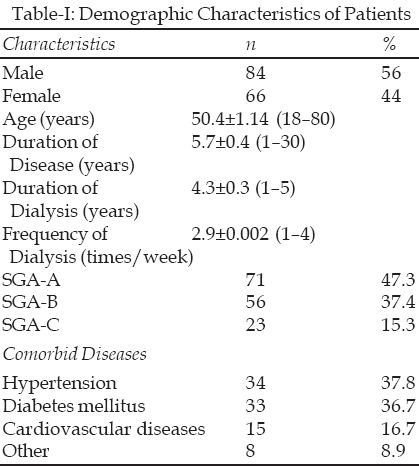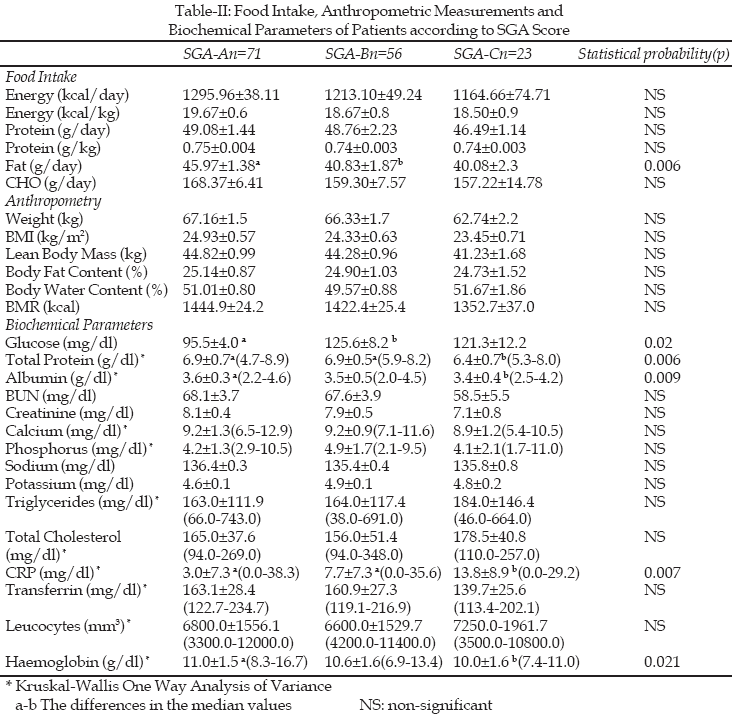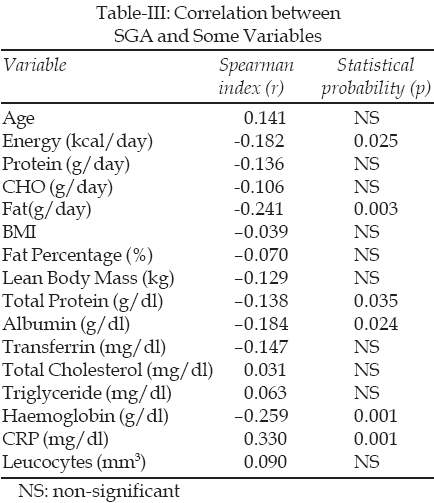|
|
||||
|
Published by : PROFESSIONAL MEDICAL PUBLICATIONS |
||||
|
ISSN 1681-715X |
||||
|
||||
|
- |
||||
|
ORIGINAL ARTICLE |
||||
|
- |
||||
|
Volume 25 |
April - June 2009 (Part-I) |
Number 2 |
||
|
|
||||
|
|
||||
|
|
||||
|
Published by : PROFESSIONAL MEDICAL PUBLICATIONS |
||||
|
ISSN 1681-715X |
||||
|
||||
|
- |
||||
|
ORIGINAL ARTICLE |
||||
|
- |
||||
|
Volume 25 |
April - June 2009 (Part-I) |
Number 2 |
||
|
|
||||
|
|
||||
Is there a correlation between subjective global assessment
and food intake, anthropometric measurement and
biochemical parameters in nutritional assessment
of haemodialysis patients?
Habibe Sahin1, Neriman İnanç2, Dilek Katrancı3, Nurse Özlem Aslan4
ABSTRACT
Objective: Subjective Global Assessment (SGA), a semi-quantitative method of evaluation for nutritional status, has a widespread use among haemodialysis patients both in research studies and in clinical practice. This study was performed to analyze possible correlations between SGA and food intake, anthropometric measurements, bioelectrical impedance (BIA) and biochemical parameters in haemodialysis patients.
Methodology: The cross-sectional study was conducted on 150 Haemodialysis (HD) patients. HD patients were assessed by SGA, 3-day food intake, anthropometry, and some biochemical parameters.
Results: According to the SGA 47.3% of patients were well nourished (SGA-A), 37.4% were moderately malnourished (SGA-B) and 15.3% were severely malnourished (SGA-C). While there was a negative correlation between energy, fat intake and SGA score (p=0.025 and p=0.003, respectively), a correlation between carbohydrate, protein intake and SGA score was not found. There were a negative correlation between SGA and serum total protein (p=0.035), albumin (p=0.024) and haemoglobin levels (p=0.001) and a positive correlation between C Reactive Protein (CRP) (p=0.001).
Conclusions: Subjective Global Assessment (SGA) was correlated with energy and fat intake and some biochemical parameters, but not with anthropometric measurements. Therefore, we conclude that further studies in which SGA with objective methods are used may be of value in determining nutritional status of haemodialysis patients.
KEY WORDS: Bioelectrical Impedance, Haemodialysis patients, Subjective Global Assessment.
Pak J Med Sci April - June 2009 Vol. 25 No. 2 201-206
How to cite this article:
Sahin H, İnanç N, Katrancı D, Aslan NO. Is there a correlation between subjective global assessment and food intake, anthropometric measurement and biochemical parameters in nutritional assessment of haemodialysis patients?. Pak J Med Sci 2009;25(2):201-206.
1. Habibe Şahin,
Assistant Professor,
2. Prof. Dr. Neriman İnanç,
Head of School,
3. Dilek Katrancı,
Research Assistant,
1-3: Department of Nutrition and Dietetics,
Atatürk Health School,
University of Erciyes,
Kayseri, 38039, Turkey
4. Nurse Özlem Aslan, PhD,
Navy Major, Turkish Naval Forces Department of Health,
Bakanliklar/Ankara, 06100, Turkey.
Correspondence
Habibe Sahin,
Assistant Professor,
Department of Nutrition and Dietetics,
Atatürk Health School, University of Erciyes,
Kayseri, 38039, Turkey.
E mail: habibesahin@hotmail.com
habibe@erciyes.edu.tr
* Received for Publication: November 19, 2008
* Accpeted: February 16, 2009
INTRODUCTION
The diagnosis of malnutrition in Haemodialysis (HD) patients requires careful assessment of the patients nutritional status.
1,2 Determining the nutritional status accurately in HD patients is one of the most difficult problems; because it depends on indirect methods as well as the accuracy of some nutritional markers are questionable.2,3The methods used in nutritional assessment include estimates of dietary intake, anthropometry, biochemical measurements and body composition analysis.
2,4 Moreover, the sensitivity of these methods in detecting early malnutrition, their practicability and their applicability to haemodialysis patients has not been convincing.1 More elaborate methods, such as dual energy X-ray absorptiometry (DEXA), Bioelectrical Impedance (BIA), total body nitrogen determinations and total body potassium estimates may give reliable results. However, these techniques are costly and their usage confines to a few major research centers.1,3Bioelectrical Impedance Analysis is a new and simple method that measures the impedance or opposition to the flow of an electric current through the body fluids contained mainly in lean and fat tissue; impedance is therefore proportional to total body water volume.
3,5,6 Subjective Global Assessment (SGA) was originally developed to assess post-operative nutritional status in hospitalized patients, but it has also been applied to nutritionally deprived patients in other clinical settings including HD.7-10In some studies it has been reported that SGA is not a reliable method and does not give accurate results because of being semi-quantitative.
11,12 Several studies have validated the claim that the SGA accurately reflects the nutritional status of haemodialysis patients.2,5,13 Although assessment of nutritional status with simple methods such as SGA could have a favourable impact on patient management, it is frequently ignored in many dialysis centers.1,3 The test uses a simple history and physical examination, which can be performed by a physician, dietitian or trained nurse.3,4 Therefore, this study was performed to analyze possible correlations between SGA and food intake, anthropometric measurements including BIA and biochemical parameters and to determine the value of the SGA as a predictor of nutritional status of HD patients.METHODOLOGY
Patients: This study was conducted on 150 patients (84 male, 66 female) on haemodialysis between of October 2005May 2006 in Kayseri, Turkey. The age of the patients ranged from 18 to 80 (50.4±1.14) years. Patients had chronic renal failure for 5.7±0.4 (130) years and they have been on HD for 4.3±0.3 (15) years. Frequency of HD treatment was 2.9±0.02 (14) times per week. Thirty seven point eight percent of patients suffered from hypertension, 36.7% from diabetes mellitus and 16.7% had cardiovascular disease.
Criteria for inclusion in the study were: age 1885 years, males and females, Haemodialysis (HD) for at least 12 months, receiving oral diet, without incidental infection, haemodialysis access via arteriovenos fistula. Criteria for exclusion from the study were: sepsis, shock, multiple organ failure, coma, clinical or surgical hospitilization in the last 30 days, ongoing enteral and parenteral nutrition, use of steroidal or non-steroidal anti-inflammatory or immume-supressive agents, cardiac pacemaker, advanced senility or dementia interfering with application of the nutritional questionnaire.
Patients underwent their treatment procedures such as receiving antihypertensive, phosphate binding, erythropoietin, iron medications and supplementation of vitamins B, C, D during the study which are recommended and applied by their physicians. All subjects gave written and verbal informed consent. This study was approved by the Ethics Committee of Faculty of Medicine, University of Erciyes (approval date 04.04.2005, number 01/122).
Food Intake:
Dietary recall forms including two days in midweek and one day in weekend were proccessed by a specialized dietitian and analyzed by a computer program (BeBiS, Stuttgart, Germany). The energy and nutrient consumed by the patients were compared with the amounts of daily energy and nutrient consumption that were recommended by RDA. The energy and nutrient intake below 33% of recommended amounts was accepted as inadequate and above 33% of recommended amounts was accepted as high.14Anthropometric Measurements: Anthropometric measurements of Haemodialysis (HD) patients were taken after haemodialysis. Body weight and height of patients were measured and their body mass indexes (BMI, kg/m
2) were calculated. Lean body mass (LBM) (kg), body fat content (%), body water content and basal metabolic rate (BMR) were measured by Bioelectrical Impedance (Bodystat 1500 Tanita).The nutritional status of patients was evaluated by the SGA described by Detsky et al.
15 This method includes five components as weight loss, food consumption, gastrointestinal symptoms, functional status and physical examinations. Information and the results for each were recorded in a subjective manner. The score between 0 and 2 refers to well nourished, 2 and 4 refers to moderately malnourished and 4 and 8 refers to severely malnourished. Based on the findings, the patients were placed in one of three nutritional categories: well nourished (SGA-A), moderately malnourished (SGA-B) or severely malnourished (SGA-C).15Biochemical Analysis: Venous blood samples were collected immeadiately before Haemodialysis (HD) after an overnight fasting. Serum glucose, total protein, albumin, blood urea nitrogen (BUN), creatinin, calcium (Ca), inorganic phosphorus (Pi), sodium (Na), potassium (K), triglycerides (TG) and total cholesterol (TC) concentrations were determined with commercial kits (Beckman-Coulter kit, USA) by an autoanalyser (MEGA MERCK, Darmstadt, Germany). Serum C-reactive protein (CRP) was determined by nephelometric method using a N High Sensitivity CRP kit (Dade Behring, Marburg GMBH, Germany) with nephelometer, transferrin was determined by Beckman-Coulter kit with Immage Immunochemistry System (California, USA.). Haematological measurements (total leucocyte and haemoglobin) were performed by an analyser (Cell-Dyn 1700, Abbott Diagnostic California, USA).
Statistical Analysis: All analyses were performed using SPSS statistical software package programme (version 15.0 for Windows; SPSS Inc., Chicago, IL, USA). Variables with normal distribution according to Kolmogrov-Smirnov test were compared between groups using the analysis of variance (One Way ANOVA). For non-normally distributed variables, analysis of Kruskal-Wallis was performed. The groups which have led to the differences were assessed by Turkeys and Dunns test, respectively. The Spearman correlation between all measured parameters were determined.
For all the analyses, p values less than 0.05 was considered significant. Data were expressed as means ± SEMs.RESULTS
According to the Subjective Global Assessment (SGA) 47.3% of patients were well nourished (SGA-A), 37.4% were moderately malnourished (SGA-B) and 15.3% were severely malnourished (SGA-C) (Table-I). The mean SGA score was 4.6±0.3 (122). Although daily fat consumption of the SGA-A group was higher than SGA-B and SGA-C groups (p=0.006), there was no difference for the other nutrients.

There was no significant difference between the groups for the body weight, BMI, LBM, (%) body fat content and total body water content and BMR. Serum glucose levels were significantly higher in SGA-A than in SGA-B (p=0.02). While total protein, albumin, haemoglobin levels were significantly lower in the SGA-C, CRP levels of this group were higher than the others (p=0.007) (Table-II). No relationship was found between SGA and age, BMI, body fat percentage and lean mass.

There was a negative correlation between SGA and serum total protein (r=0.138, p=0.035), albumin (r=0.184, p=0.024) and haemoglobin (r=0.259, p=0.001) and a positive correlation between CRP (r=+0.330, p=0.001). A significant positive correlation between body fat percent and daily fat intake in SGA-C was determined. While there was a negative correlation between energy, fat intake and SGA score (r=-0.182, p=0.025 and r= 0.241, p=0.003, respectively), a correlation between carbohydrate, protein intake and SGA score was not found (Table-III).

DISCUSSION
Subjective Global Assessment (SGA), as a semi-quantitative method of assessment for nutritional status, has a widespread use among Haemodialysis (HD) patients both in research studies and in clinical practice. In this study, although there was not a significant correlation between age and SGA, SGA score increased with age. Similarly, Faintuch et al.,
10 pointed out an increase in SGA score especially in older HD patients because of chronic diseases. By SGA estimation, 37.4% of the patients were moderately and 15.3% were severely malnourished in the present study. The rate of severely malnourished patients in this study showed similarity to the results of Faintuch et al.10 who found severe malnutrition rate as 13%. The moderate malnutrition rate determined in the present study is lower than the rate found in the study of Faintuch et al.10 In contrast to many studies5,8,12 lack of the correlation between SGA and anthropometric measurements in the present study may be due to the low rate of patients with severe malnutrition.Bioelectrical Impedance Analysis is a rapid, inexpensive, reliable and non-invasive method that is used for determination of nutritional status and has been performed on several groups of patients including HD.
2,5,6,10,16 The negative correlation between SGA and the results of BIA measurements (fat percentage, lean body mass) and BMI which reflect the body composition was not significant as indicated in previous studies.1,10It is known that energy and nutrient intakes of patients on HD are inadequate. Total energy intake was low (19.1±5.26kcal/day) but protein intake was quite acceptable (0.75±0.23g/kg/day) in this study.
17 The National Institutes of HealthSponsored Haemodialysis (HEMO) team reports not more than 22.7±8.2kcal/day and 0.9±0.4 grams of protein/kg/day intake in their most recent communications. Many of the respected international cooperative protocols of haemodialysis populations are compatible with our results.4,18,19 Daily fat intake of severe malnourished patients (SGA-C) was significantly lower than well nourished patients (SGA-A).The significant positive correlation between body fat percentage and daily fat intake in SGA-C confirms this result.Most dialysis patients with malnutrition have co-morbid diseases. In this study, 37.8% of patients suffered from hypertension, 36.7% from DM and 16.7% had cardiovascular disease. Serum glucose levels were higher in SGA-B than in the others. This result may be due to the presence of diabetic HD patients in SGA-B.
Serum albumin has frequently been used as a marker of nutritional status.
19 In the present study, like many other studies.8, 10, 16 statistically significant lower level of serum albumin was determined when comparing well-nourished and moderately malnourished HD patients. The systemic inflammatory response stimulates protein catabolism and the release of amino acids from the muscle protein providing substrates for the synthesis of acute phase proteins and proteins of the immun system, which could result in a general reduction in plasma amino acid concentrations.20-22 Because proinflammatory cytokines can cause anorexia and increase protein catabolism, they present an important cause of protein wasting in chronic renal disease.19,20 In the present study, the lower albumin levels may reflect the protein catabolism because of the inflammation20 which may cause an increase in the CRP synthesis in the liver.10,23CONCLUSION
The nutritional status in patients on Haemodialysis (HD) needs more attention. The present study showed an association between Subjective Global Assessment and energy and fat intake and some biochemical parameters except for anthropometric measurements. Therefore, we conclude that further studies in which Subjective Global Assessment (SGA) with objective methods are used may be of value in determining nutritional status of haemodialysis patients.
REFERENCES
1. Kalantar-Zadeh K, Kleiner M, Dunn E, Lee GH, Luft FC. A modified quantitative subjective global assessment of nutrition for dialysis patients. Nephrol Dial Transplant 1999;14(7):1732-8.
2. Passadakis P, Sud K, Dutta A, Singhal M, Pettit J, Chatalalsingh C, et al. Bioelectrical impedance analysis in the evaluation of the nutritional status of Continuous Ambulatory Peritoneal Dialysis Patients. Adv Perit Dial 1999;15:147-52.
3. Chumlea WC. Anthropometric and body composition assessment in dialysis patients. Seminars in Dialysis 2004;17(6):466-70.
4. Locatelli F, Fouque D, Heimburger O. Nutritional status in dialysis patients: A European consensus. Nephrol Dial Transplant 2002;17:563-72.
5. Mushnick R, Fein PA, Mittman N, Goel N, Chattopadhyay J, Avram M. Relationship of bioelectrical impedance parameters to nutrition and survival in peritoneal dialysis patients. Kidney Int 2003;64:53-6.
6. Katzarski K, Charra B, Laurent G, Lopot F, Nisell J, Bergström J. Multifrequency bioimpedance in assessment of dry weight in haemodialysis. Nephrol Dial Transplant 1996;11(2):20-3.
7. Enia G, Sicuso C, Alati G, Zoccali C. Subjective global assessment of nutrition in dialysis patients. Nephrol Dial Transplant 1993;8:1094-8.
8. Jones CH, Wolfenden RC, Wells L. Is subjective global assessment a reliable measure of nutritional status in hemodialysis, J Renal Nutr 2004;14(1):26-30.
9. Stenvinkel P, Barany P, Chung SH, Lindholm B, Heimb-ürger O. A comparative analysis of nutritional parameters as predictors of outcome in male and female ESRD patients. Nephrol Dial Transplant 2002;17(7):1266-74.
10. Faintuch J, Morais AAC, Silva MAT, Vidigal EJ, Costa RA, Lyrio DC, et al. Nutritional profile & inflammatory status of haemodialysis patients. Renal Failure 2006;28:295-301.
11. Atasoyu EM, Ünver S, Evrenkaya TR, Tülbek MY. Sübjektif Global Değerlendirme Hemodiyaliz Hastalarında Beslenme Durumunu Değerlendirmede Güvenilir Bir Ölçüt Değildir. Türk Nefroloji Diyaliz ve Transplantasyon Dergisi 2003;12(3):134-40.
12. Cooper BA, Bartlett LH, Aslani A, Allen BJ, Ibels LS. Pollock CA. Validity of subjective global assessment as a nutritional marker in end-stage renal disease. Am J Kidney Disease 2002;40(1):126-32.
13. Young GA, Kopple JD, Lindholm B, Vonesh EF, De Vecchi A, Scalamogna A, et al. Nutritional assessment of continuous ambulatory peritoneal dialysis patients: An international study. Am J Kidney Dis 1991;7:462-71.
14. Baysal A, Bozkurt N, Pekcan G, Besler HT, Aksoy M, Merdol TK, et al. Diyet El Kitabı. 4. Baskı, Hatipoğlu Yayınevi, Ankara, 2003.
15. Detsky AS, McLauhlin JR, Baker JP, Johnston N, Whittaker S, Mendelson RA, et al. What is subjective global assessment of nutritional status? JPEN 1987;11:8-13.
16. Morais AAC, Silva MAT, Faintuch J, Vidigal EJ, Costa RA, Lyrio DC. Correlation of nutritional status and food intake in hemodialysis patients. Clinics 2005;60(3):185-92.
17. Toigo G, Aparicio M, Atman PO, Cano N, Cianciaruso B, Engel B, et al. Expert Working Group report on nutrition in adult patients with renal insufficiency (part 1 of 2). Clin Nutr 2000;19(3):197-207.
18. National Kidney Foundation: K/DOQI Clinical practice guidelines for nutrition in chronic renal failure. Am J Kidney Dis 2000;35(suppl 2):S1-S140.
19. Kaysen GA, Don BR. Factors that affect albumin concentration in dialysis patients and their relationship to vascular disease. Kidney Int (suppl) 2003;84:94-7.
20. Suliman ME, Qureshi AR, Stenvinkel P, Pecoits-Filho R, Barany P, Heimburger O. Inflammation contributes to low plasma amino acid concentrations in patients with chronic kidney disease. Am J Clin Nutr 2005;82(2):342-9.
21. Rasic-Milutinovic R, Perunicic G, Pljesa S, Gluvic Z, Ilic M, Stoki E. Metabolic syndrome in HD patients: association with body composition, nutritional status, inflammation and serum iron. Intern Med 2007;46(13):945-51.
22. Kaysen GA. Inflammation, nutritional state and outcome in end stage renal disease. Miner Electrolyte Metabol 1999;25:242-50.
23. Nascimento MM, Pecoits-Filho R, Qureshi AR, Hayashi SY, Manafro RC, Pachaly MA, et al. The prognostic impact of fluctuating levels of C-reactive protein in Brazilian hemodialysis patients: a prospective study. Nephrol Dial Transplant 2004;19(11):2803-9.
HOME | SEARCH | CURRENT ISSUE | PAST ISSUES
Professional
Medical Publications
Room No. 522, 5th Floor, Panorama Centre
Building No. 2, P.O. Box 8766, Saddar, Karachi - Pakistan.
Phones : 5688791, 5689285 Fax : 5689860
pjms@pjms.com.pk